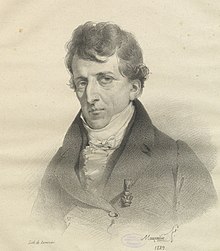Giovanni Aldini
Giovanni Aldini | |
|---|---|
 Portrait of Giovanni Aldini, 1829 | |
| Born | 10 April 1762 Bologna, Papal States |
| Died | 17 January 1834 (aged 71) |
| Alma mater | University of Bologna |
Giovanni Aldini (10 April 1762 – 17 January 1834)[1] was an Italian physician[2] and physicist born in Bologna. He was a brother of the statesman Count Antonio Aldini (1756–1826). He graduated in physics at University of Bologna in 1782.[3]
He became professor of experimental physics at University of Bologna in 1798, in succession to his uncle Luigi Galvani (1737–1798).[4] His scientific work was chiefly concerned with galvanism, anatomy and its medical applications, with the construction and illumination of lighthouses, and with experiments for preserving human life and material objects from destruction by fire. He wrote in French and English in addition to his native Italian, and in Latin, still used in the 18th century by the scientific community. In recognition of his merits, the emperor of Austria made him a Knight of the Iron Crown and a councillor of state at Milan, where he died. He bequeathed a considerable sum to found a school of natural science for artisans at Bologna.[1]
Experiments
[edit]

Aldini's most famous public demonstration of the electro-stimulation technique of deceased limbs was performed on the executed criminal George Forster at Newgate in London in 1803.[5][6] The Newgate Calendar describes what happened when the galvanic process was used on the body:
On the first application of the process to the face, the jaws of the deceased criminal began to quiver, and the adjoining muscles were horribly contorted, and one eye was actually opened. In the subsequent part of the process the right hand was raised and clenched, and the legs and thighs were set in motion.[7]
Shelley's Frankenstein association
[edit]Mary Shelley (born Mary Godwin 30 August 1797) would have been only 5 years old in January 1803 when Aldini experimented on the corpse of George Foster. In her introduction to the 1831 edition of Frankenstein she does not mention Aldini, but "galvanism" was among the evening discussion topics before she experienced her "waking dream" that led to her writing.[8] Chapter 5, the creature awakened:
By the glimmer of the half-extinguished light, I saw the dull yellow eye of the creature open; it breathed hard, and a convulsive motion agitated its limbs.
References
[edit]- ^ a b One or more of the preceding sentences incorporates text from a publication now in the public domain: Chisholm, Hugh, ed. (1911). "Aldini, Giovanni". Encyclopædia Britannica. Vol. 1 (11th ed.). Cambridge University Press. p. 536.
- ^ "This Real Doctor's Crazy Experiments Inspired 'Frankenstein'". All That's Interesting. 20 November 2017. Retrieved 4 April 2020.
- ^ Giovanni Aldini: From Animal Electricity to Human Brain Stimulation.
- ^ Parent, Andre (December 2004). "Giovanni Aldini: From Animal Electricity to Human Brain Stimulation". The Canadian Journal of Neurological Sciences. 31 (4): 576–84. doi:10.1017/S0317167100003851. PMID 15595271.
- ^ "AIM25 text-only browsing: Royal College of Surgeons of England: Aldini, Giovanni: Notebook". Aim25.ac.uk. Archived from the original on 3 March 2016. Retrieved 5 August 2012.
- ^ "Early Nineteenth century electrochemistry". Retrieved 21 October 2010.
- ^ The Newgate Calendar – George Foster Executed at Newgate, 18th of January, 1803, for the Murder of his Wife and Child, by drowning them in the Paddington Canal; with a Curious Account of Galvanic Experiments on his Body
- ^ Shelley, Mary. "Introduction" Frankenstein (1831 edition) Gutenberg
"Perhaps a corpse would be re-animated; galvanism had given token of such things: perhaps the component parts of a creature might be manufactured, brought together, and endued with vital warmth."
Further reading
[edit]- Dibner, Bern (1970). "Giovanni Aldini". Dictionary of Scientific Biography. Vol. 1. New York: Charles Scribner's Sons. pp. 107–108. ISBN 978-0-684-10114-9.
External links
[edit]- Mark Pilkington: Sparks of Life. Article from The Guardian about Aldini's experiments on an executed criminal.
- A. Parent: Giovanni Aldini: from animal electricity to human brain stimulation. (PDF), Can J Neurol Sci. 2004 Nov;31(4):576-84.
